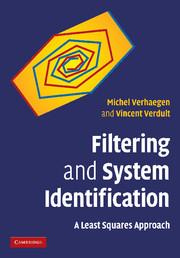Book contents
- Frontmatter
- Contents
- Preface
- Notation and symbols
- List of abbreviations
- 1 Introduction
- 2 Linear algebra
- 3 Discrete-time signals and systems
- 4 Random variables and signals
- 5 Kalman filtering
- 6 Estimation of spectra and frequency-response functions
- 7 Output-error parametric model estimation
- 8 Prediction-error parametric model estimation
- 9 Subspace model identification
- 10 The system-identification cycle
- References
- Index
1 - Introduction
Published online by Cambridge University Press: 14 January 2010
- Frontmatter
- Contents
- Preface
- Notation and symbols
- List of abbreviations
- 1 Introduction
- 2 Linear algebra
- 3 Discrete-time signals and systems
- 4 Random variables and signals
- 5 Kalman filtering
- 6 Estimation of spectra and frequency-response functions
- 7 Output-error parametric model estimation
- 8 Prediction-error parametric model estimation
- 9 Subspace model identification
- 10 The system-identification cycle
- References
- Index
Summary
Making observations through the senses of the environment around us is a natural activity of living species. The information acquired is diverse, consisting for example of sound signals and images. The information is processed and used to make a particular model of the environment that is applicable to the situation at hand. This act of model building based on observations is embedded in our human nature and plays an important role in daily decision making.
Model building through observations also plays a very important role in many branches of science. Despite the importance of making observations through our senses, scientific observations are often made via measurement instruments or sensors. The measurement data that these sensors acquire often need to be processed to judge or validate the experiment, or to obtain more information on conducting the experiment. Data are often used to build a mathematical model that describes the dynamical properties of the experiment. System-identification methods are systematic methods that can be used to build mathematical models from measured data. One important use of such mathematical models is in predicting model quantities by filtering acquired measurements.
A milestone in the history of filtering and system identification is the method of least squares developed just before 1800 by Johann Carl Friedrich Gauss (1777–1855). The use of least squares in filtering and identification is a recurring theme in this book. What follows is a brief sketch of the historical context that characterized the early development of the least-squares method.
- Type
- Chapter
- Information
- Filtering and System IdentificationA Least Squares Approach, pp. 1 - 7Publisher: Cambridge University PressPrint publication year: 2007



